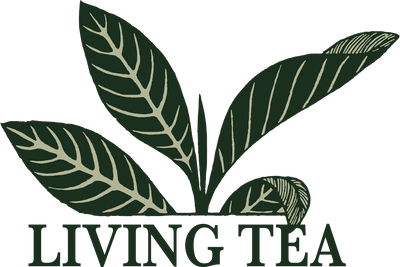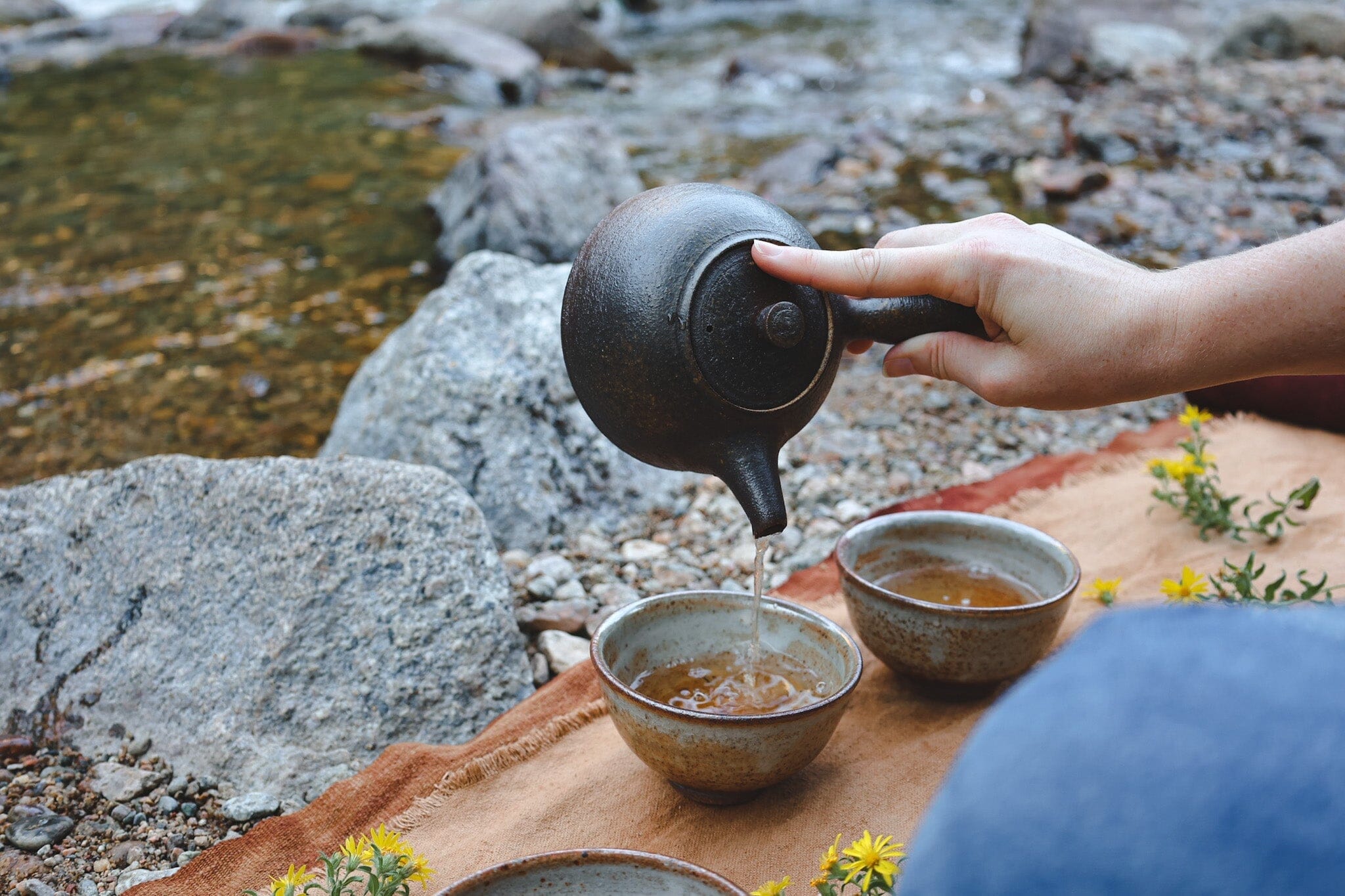Sitting under the awning of Mountain Gate Teahouse, I breathe deeply the sweet humidity that fills the air as the late summer afternoon rains descend. The alpine glow on the distant peaks hints at the shortening days, having turned the corner on June 22, the longest day of the year. This period until September 22nd, the autumn equinox, represents a time of ripening fruit and vegetables, lingering summer heat, the settling of fiery yang energy into the cool, condensed metal energy of the fall.
A Time of Reflection and Transformation
This past year has presented unimaginable challenges to so many people affected by a worldwide pandemic, economic challenges, social upheaval, the rise of increased digital communication, and general social distance. We’ve all had more time to deliberate upon our most cherished beliefs about the reliability of the social structures that we once took for granted, as well as our personal life path and what matters most to us. Never in modern history have we as humans been so collectively humbled by our fragility. Never have we had to be so patient and isolated. We sense that through this experience we have the opportunity to recognize the unity and shared experiences of the entire planet.
With the opening of the teahouse on July 15th, we’ve had a beautiful opportunity to connect and share with our local community, as well as visitors from out of town. The experience has been humbling, healing, and inspiring as we recognize the hardships that so many have faced, along with the remarkably resilient, creative, and hopeful power of human solidarity. While we still have a long way to go in overcoming the many challenges of this time, we remain steadfast in our belief that we are part of something much bigger than ourselves, and that we will emerge transformed for the better.
At the heart of the way of tea is an appreciation for impermanence, change, and transformation. By aligning ourselves with change, we can better navigate a reality that is defined by patterns of transformation. In the words of the ancient oracle, The Book of Changes or I-Ching:
"Thus, Knowing-How is the maintenance of life.
Do not fail to observe the Four Seasons
And to adapt to heat and cold,
To harmonize elation and anger,
And to be calm in activity as in rest,
To regulate yin and yang,
And to balance the hard and soft.
In this way, having deflected the perverse energies,
There will be long life and everlasting vision."
While constant change is a law of reality, the way that we relate to those transformations will determine how well we navigate life. So much of our human suffering comes from persistent resistance to what IS. This resistance creates an inner friction that produces a subtle belief that we must always fight against reality, yet this is a struggle that cannot be won. The watercourse way is one of finding alignment and flow, which is a practice that can be developed through consistent acceptance and surrender to the realities of the moment. This is the practice of Presence, and it is always available, just on the other side of our discursive thoughts and the pesky chatter of our egos.
For every situation, we have three routes or choices that we can make: change the situation, accept the situation as it is, or walk away. This simple orientation can make complex interpersonal situations more manageable. On a larger scale, by learning to align with the ever-present change of the seasons, we align with the law of change, and develop a more balanced life. In Taoist medicine, this practice serves as the foundation for sound health of body, mind, and spirit.
Aligning with the Fall
In previous tea clubs, we have explored in depth the many ways that we can align with each season. These include seasonal diets and their influence on our physiology, emotions associated with each season, modern social realities and how they impact us, the five elements, seasonal movement, and the general approach to seasonal living as taught through Taoist medicine. The Spring tea club went into depth about the role of tea in the metamodern age, while the Summer tea club explored the coronavirus, herbal preventative treatments, and the six pillars of health to support immunity. We suggest exploring the previous tea clubs through our blog in order to deep dive into what it means to align with the Fall.
During this intermediary period of August and September, the heat and movement of summer mellow into the sweet Earth element. This is a time when yang and yin maintain a harmonious balance. We enjoy long warm days, well-being, ease within the body and mind, and digestion of the experiences that come from Spring and Summer movement. The color associated with the season is yellow, as the earth begins to dry up under the influence of the yellow sun, and ripened fruit falls from trees.
The Energy of Autumn
Anatomically, this period is associated with the digestive system, which we rely on to absorb nutrients and maintain vitality. As late summer passes into autumn, the Earth becomes cool and dry, contracted and condensed, drawing inward for accumulation and storage. The fall is a time of stability, fertility, nurturance, and containment, which imbue an organism with the ability to sustain itself and others, and to reap the harvest of its own life. This time of the Metal energy is when the crops of summer are cut, harvested, and stored for their use in winter.
Wastes are eliminated, like winnowing chaff from wheat, and the essence is kept. Before the mechanized modern age, the Autumn harvest was extraordinarily important as we required sufficient stores for the winter for survival and to generate a healthy, strong new cycle in the spring. Metal energy is related to the lungs, which are responsible for exchanging fresh oxygen from the environment for carbon dioxide from the body's cells, as well as the large intestine, which eliminates waste while retaining vital fluids. Just as the trees shed their leaves and bees drive drones from the hive, this time of the year is about bringing in (lungs) fresh inspiration while letting go (large intestine) of stale emotions, unnecessary attachments, excess baggage, and unresolved energies from the Summer.
Autumn is a time of hardening seeds, fallen leaves, and sinking sap, as well as the qualities of inspiration and endurance. Just as animals begin to store food away, we too become more internal and less carefree than summer. This is a time for gathering, storage, preparation, and protecting. This is a time to focus on what is essential as we head into the quiet, meditative months of winter. By defying this natural process and clinging to attachments, we are likelier to experience melancholy, grief, and anxiety. These feelings that “weigh heavy on our chests” can affect the lungs and large intestines, manifesting as breathing difficulties, flu, colds, respiratory issues, chest pain, skin problems, and low immunity.
Thus, late Summer and Autumn are times for extracting, digesting, and refining lessons from the previous active seasons and letting go of excess. We move inward to cultivate and protect our interior lives, work on indoor projects, complete projects begun in the spring, and let go of that which no longer serves us.
The Importance of Meditation
We find meditation to be as essential to health as good food, water, and sleep. Through meditation, we cut through the many illusions created by our cluttered lives and minds. The metal element of fall contains this energy of cutting away the superfluous things in our lives so that we might see what is essential. While we are absolutely open to exploring all religious faiths, we find the teachings of Gautama Buddha to be particularly instructive in the realm of meditation. We also find that Buddhism is a philosophy that welcomes all points of view, studies them critically, and then steps beyond them into reality—into the real world. Finally, tea and Zen have a long relationship, both containing paths that lead to the same reality.
To that end, we’d like to share an interpretation by Zen master Gudo Nishijima of the four noble truths. This beautiful interpretation can be found in the book To Meet the Real Dragon, and we believe that it can serve as a good inspiration for meditation as we head into the more “inward” months of Fall and Winter.
Exploring the Four Noble Truths
While an extensive exploration of the four noble truths exceeds the scope of this pamphlet, we can offer a glimpse. In short, the four truths examine a cogent theory that includes the complexities of life while offering a logical way of managing those complexities, both theoretically and practically.
To summarize Master Nishijima’s interpretation, humans are thinking beings who produce images that appear real yet which are devoid of substance. We come to believe that these limitless thoughts are reality, and we wish to realize the hopes and dreams that emerge from them. At some point, with inquiry, we see the discrepancies between dreams and reality, which causes disappointment or suffering. As we begin to move out of the realm of self-centered ideas, dreams, and beliefs, we begin to examine the world of facts, matter, and objectivity.
We explore how the world is constructed, what it is made of, and how it actually works. This precise observation leads us to the reductionist and materialistic view of reality and the universe in which the whole is composed of infinitely small, undifferentiated parts. We then come to see that every part is connected to a vast web of cause and effect, an accumulation of interrelated dependently originated parts. This philosophy based on the sensory perception of the universe has no place for the mind or spirit of human beings as a materialist reality denies the insubstantial world of images, dreams, and thoughts.
The Buddha resolved this contradiction by presenting a reality where the mental world and the physical world meet. That place is the here and now, the place of meditation, the place where idealism and material meet. Stepping beyond while maintaining the world of discursive thoughts, philosophies, and theories, we experience the ineffable reality itself. Meditation is the gate, the practice, and the experience of direct realization of the real world. The practice of mindful tea is meditation in action.
We invite you to explore meditation and will begin sharing our weekly meditations very soon so that you have inspiration and instruction to join. We will also offer simple instructions on how to start a tea practice and our weekly ceremonies. We suggest following Living Tea on Instagram to stay posted.
Teas for Fall
In general, during the fall, we tend to drink teas that are rich, nourishing, grounding, roasted, and mildly sweet. There is less activity during colder months, so we tend towards less stimulating teas. Instead, we emphasize teas to support and tonify the organs, fluids, and blood. Late summer and early autumn are times to clear excess summer heat from the body and to support the digestive system. For this purpose, we drink teas that combine bitter heat-clearing qualities, pungent or “spicy” teas to promote circulation, and mildly sweet teas that support digestion. Mid to late autumn is a time to protect the body from cold, wind, and dryness. We then tend towards teas that are mildly sweet to support digestion of heavier foods, slightly sour to prevent the loss of body fluids and counteract the dry environment, or aged teas to generate warmth, especially as we get later in autumn.
To simplify, early autumn is a good time for slightly bittersweet young to mid-aged sheng Puerh, and bittersweet roasted Oolongs. Mid to late autumn is an ideal time for slightly sour Hunan Black Tea, sweet “yellow leaf” Huang Pian Sheng Puerh, warming aged Oolong, rich earthy Yencha or Cliff tea, and mellow red tea.

